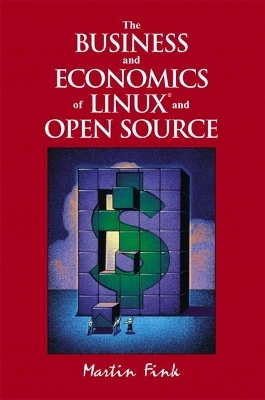
The Business and Economics of Linux and Open Source
Prentice Hall (Verlag)
978-0-13-047677-7 (ISBN)
- Titel ist leider vergriffen;
keine Neuauflage - Artikel merken
Open Source has become a buzzword synonymous with growth and change in computing. Many of the Fortune 500 companies have made huge investments in Open Source technology. This book examines the Open Source movement, what's worked and why, and explains the technology to the mainstream investor and manager looking to replicate the successes of the Open Source movement. The book begins with an overview of the business motivations for deploying Linux and Open Source applications in the enterprise, then covers the details of what Linux is, understanding the effect of open source licenses on business and a view into the wide ranging open source communities doing active development. Next, the book takes a look at how Linux is distributed to the end user base and takes a look at the true costs of Linux and open source. In the final section, the book explains in detail how open source development takes place and how business can and should take advantage of it. The book ends with a series of open source business models and a listing of talent management working within the open source community.
MARTIN FINK is General Manager for Hewlett-Packard's Linux Systems Division, where he has been leading Linux development activities for more than three years. He is responsible for driving HP's overall Linux and open source strategy and managing the firm's open source business processes. He is also Vice President of the Board of Directors for the Open Source Development Lab, a global consortium of industry leaders dedicated to promoting Linux and Linux-based programming for enterprise and carrier-class environments.
Disclaimer and Notices.
Acknowledgments.
Preface.
I. GROUNDWORK.
1. The Business of Linux and Open Source.
Linux Adoption. Crash Course in Linux and Open Source Lingo. Linux Workloads. Business Benefits. Inhibitors to Linux Growth. Who's Who in Open Source? Summary.
2. Linux—Heart of the Operating System.
The Operating System. The Linux Kernel. Kernel Fragmentation (or Forking). Linux Kernel Development and Version Control. Multi-Platform Support. Linux on the Desktop. Vertical and Horizontal Scalability. Embedded Linux. Summary.
3. Open Source—Navigating the Legal Path to Freedom.
The Freedom to Be Open Source. The Open Source Definition. Intellectual Property and Reciprocity. Dual-Licensing and Copyright Ownership. Licenses—Open Source and Non-Open Source. Export and Cryptography. Open Source Development Methodology. Summary.
4. Communities and Organizations.
Linux. Web Services and Application Servers. Languages. Desktops and Office Productivity. Databases. Personal Digital Assistants. Clusters. Organizations. Summary.
II. OPERATIONAL LINUX.
5. Distributions—Completing Linux.
Linux Distribution. Packages. Distribution Vendors. Non-Linux Operating System Distributions. Creating Your Own Distribution. Supporting Multiple Distributions. Standards. Summary.
6. The Cost of Linux and Open Source.
The Costs. Adapting to an Imperfect Solution. Procuring Linux and Open Source Software. Modifying Open Source Software. Summary.
7. Standards—One Linux.
Why Standards? Free Standards Group. Linux Standards Base. Linux Internationalization. Testing and Conformance. Specialized Linux Distributions. Summary.
8. Operations—Using Linux and Open Source.
Deployment. Migration and Coexistence. Licensing and Purchasing. Support. Training. Summary.
III. OPEN SOURCE IN BUSINESS.
9. The Corporate Bazaar.
The Cathedral and the Bazaar. Structure Follows Strategy. Structural Bazaar. Other Structural Elements. Gated Communities. Risks and Issues. Summary.
10. Value as a Function of Time.
Pharmaceutical Industry. Open Source Effect on Software. Devaluation as a Competitive Advantage. Value Stuck in Time. Summary.
11. Business Models—Making Money.
Know Your Value. Commercial Software and Linux. Support and Services Tied to Open Source. Aggregating and Enhancing. Commercializing with a Dual-License. Hardware. End-of-Life Model. Building an Ecosystem. Summary.
12. Integrating Open Source Into Your Business.
Outbound Open Source. Inbound Open Source. IT Development. Indemnification. Summary.
13. Human Resources—Getting Top Talent.
Employment Contracts. Participation Policies. Hiring the Right Person. Structuring the Teams. Hiring Visible Leaders. Summary.
Appendix A. References and Resources.
Appendix B. Sample Copyright Assignment.
Appendix C. The GNU General Public License Reference.
Index.
| Erscheint lt. Verlag | 7.11.2002 |
|---|---|
| Verlagsort | Upper Saddle River |
| Sprache | englisch |
| Maße | 154 x 228 mm |
| Gewicht | 380 g |
| Themenwelt | Informatik ► Betriebssysteme / Server ► Unix / Linux |
| Wirtschaft ► Betriebswirtschaft / Management ► Unternehmensführung / Management | |
| ISBN-10 | 0-13-047677-3 / 0130476773 |
| ISBN-13 | 978-0-13-047677-7 / 9780130476777 |
| Zustand | Neuware |
| Haben Sie eine Frage zum Produkt? |
aus dem Bereich


